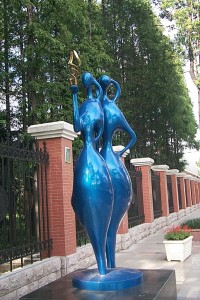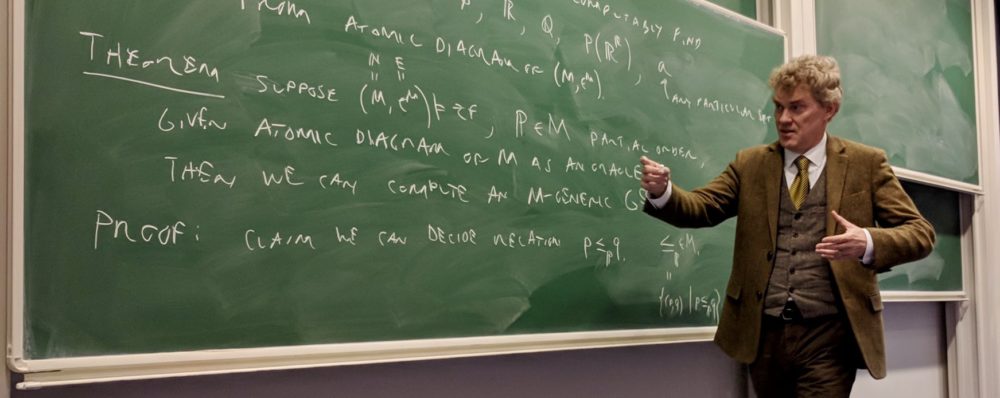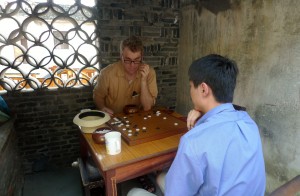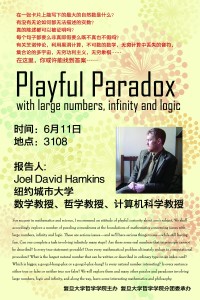I’ll be participating in a workshop at the University of Connecticut, Storrs, philosophy department on October 26-27, 2013, on paraconsistent set theory, organized by Graham Priest and JC Beall. I am given to understand that part of the goal is to develop additional or improved model-construction methods, with which one might expand the range of possible behaviors that we know about.
Category Archives: Talks
Universal structures: the countable random graph, the surreal numbers and the hypnagogic digraph, Swarthmore College, October 2013
I’ll be speaking for the Swarthmore College Mathematics and Statistics Colloquium on October 8th, 2013.

Abstract. I’ll be giving an introduction to universal structures in mathematics, where a structure $\mathcal{M}$ is universal for a class of structures, if every structure in that class arises as (isomorphic to) a substructure of $\mathcal{M}$. For example, Cantor proved that the rational line $\mathbb{Q}$ is universal for all countable linear orders. Is a corresponding fact true of the real line for linear orders of that size? Are there countably universal partial orders? Is there a countably universal graph? directed graph? acyclic digraph? Is there a countably universal group? We’ll answer all these questions and more, with an account of the countable random graph, generalizations to the random graded digraphs, Fraïssé limits, the role of saturation, the surreal numbers and the hypnagogic digraph. The talk will conclude with some very recent work on universality amongst the models of set theory.
Embeddability amongst the countable models of set theory, plenary talk for ASL / Joint Math Meetings in Baltimore, January 2014
A one-hour plenary talk for the ASL at the Joint Math Meetings, January 15-18, 2014 in Baltimore, MD.
Saturday January 18, 2014, 2:00 p.m.-2:50 p.m, Room 319 BCC
Abstract. A surprisingly vigorous embeddability phenomenon has recently been uncovered amongst the countable models of set theory. In particular, embeddability is linear: for any two countable models of set theory, one of them is isomorphic to a submodel of the other. In particular, every countable model of set theory, including every well-founded model, is isomorphic to a submodel of its own constructible universe, so that there is an embedding $j:M\to L^M$ for which $x\in y\iff j(x)\in j(y)$. The proof uses universal digraph combinatorics, including an acyclic version of the countable random digraph, which I call the countable random $\mathbb{Q}$-graded digraph, and higher analogues arising as uncountable Fraïssé limits, leading to the hypnagogic digraph, a set-homogeneous, class-universal, surreal-numbers-graded acyclic class digraph, closely connected with the surreal numbers.
Panelist at the Infinity Salon for the World Science Festival, NYC, June 2013
![]() The World Science Festival is coming to New York (May 29 — June 2), with numerous interesting events, including the infinity salon, an intimate, free-wheeling discussion about infinity, entitled The future of Infinity: Solving Math’s most notorious problem, for an audience of experts.
The World Science Festival is coming to New York (May 29 — June 2), with numerous interesting events, including the infinity salon, an intimate, free-wheeling discussion about infinity, entitled The future of Infinity: Solving Math’s most notorious problem, for an audience of experts.
I shall be on the panel along with Steven Strogatz, W. Hugh Woodin and others, moderated by Keith Devlin.
I’m looking forward to it!
(Note that tickets are required for many events.)
From the salon web site:
Saturday, June 1, 2013
3:30 PM – 5:00 PM
In 1873, Georg Cantor proved that there are different sizes of infinity. Cantor tried to answer the question by proposing the Continuum Hypothesis. A solution of sorts was found in 1963, but the answer—proof that there was no proof—raised questions about the foundations of mathematics. Most deemed that counting the infinite was beyond mathematical precision. Recently, progress has been made, and the Continuum Hypothesis might have a definite answer—true or false.
The World Science Festival’s annual salon series offers in-depth conversations with leading scientists, extending the discussion of the Festival’s premiere public programs to graduate students, postdocs, faculty and well-informed members of the general public.
A multiverse perspective in mathematics and set theory: does every mathematical statement have a definite truth value? Shanghai, June 2013
 This will be a talk for specialists in philosophy, mathematics and the philosophy of mathematics, given as part of the workshop Metamathematics and Metaphysics, June 15, 2013, sponsored by the group in Mathematical Logic at Fudan University.
This will be a talk for specialists in philosophy, mathematics and the philosophy of mathematics, given as part of the workshop Metamathematics and Metaphysics, June 15, 2013, sponsored by the group in Mathematical Logic at Fudan University.
Abstract: Much of the debate on pluralism in the philosophy of set theory turns on the question of whether every mathematical and set-theoretic assertion has a definite truth value. A traditional Platonist view in set theory, which I call the universe view, holds that there is an absolute background concept of set and a corresponding absolute background set-theoretic universe in which every set-theoretic assertion has a final, definitive truth value. I shall try to tease apart two often-blurred aspects of this perspective, namely, to separate the claim that the set-theoretic universe has a real mathematical existence from the claim that it is unique. A competing view, the multiverse view, accepts the former claim and rejects the latter, by holding that there are many distinct concepts of set, each instantiated in a corresponding set-theoretic universe, and a corresponding pluralism of set-theoretic truths. After framing the dispute, I shall argue that the multiverse position explains our experience with the enormous diversity of set-theoretic possibility, a phenomenon that is one of the central set-theoretic discoveries of the past fifty years and one which challenges the universe view. In particular, I shall argue that the continuum hypothesis is settled on the multiverse view by our extensive knowledge about how it behaves in the multiverse, and as a result it can no longer be settled in the manner formerly hoped for.
The talk will engage with ideas from some of my recent papers on the topic:
Universality, saturation and the surreal number line, Shanghai, June 2013
 This will be a short lecture series given at the conclusion of the graduate logic class in the Mathematical Logic group at Fudan University in Shanghai, June 13, 18 (or 20), 2013.
This will be a short lecture series given at the conclusion of the graduate logic class in the Mathematical Logic group at Fudan University in Shanghai, June 13, 18 (or 20), 2013.
I will present an elementary introduction to the theory of universal orders and relations and saturated structures. We’ll start with the classical fact, proved by Cantor, that the rational line is the universal countable linear order. But what about universal partial orders, universal graphs and other mathematical structures? Is there a computable universal partial order? What is the countable random graph? Which orders embed into the power set of the natural numbers under the subset relation $\langle P(\mathbb{N}),\subset\rangle$? Proceeding to larger and larger universal orders, we’ll eventually arrive at the surreal numbers and the hypnagogic digraph.

Playful paradox with large numbers, infinity and logic, Shanghai, June 2013
This will be a talk at Fudan University in Shanghai, China, June 12, 2013, sponsored by the group in Mathematical Logic at Fudan, for a large audience of students.
Abstract: For success in mathematics and science, I recommend an attitude of playful curiosity about one’s subject. We shall accordingly explore a number of puzzling conundrums at the foundations of mathematics concerning issues with large numbers, infinity and logic. These are serious issues—and we’ll have serious things to say—while still having fun. Can one complete a task involving infinitely many steps? Are there some real numbers that in principle cannot be described? Is every true statement provable? Does every mathematical problem ultimately reduce to computational procedure? What is the largest natural number that can be written or described in ordinary type  on an index card? Which is bigger, a googol-bang-plex or a googol-plex-bang? Is every natural number interesting? Is every sentence either true or false or neither true nor false? We will explore these and many other puzzles and paradoxes involving large numbers, logic and infinity, and along the way, learn some interesting mathematics and philosophy. The Largest-Number Contest. In preparation for the talk, and with a nod to Douglas Hofstadter, we shall be holding a contest: Who can describe the largest number on an ordinary index card? See the contest announcement poster.
on an index card? Which is bigger, a googol-bang-plex or a googol-plex-bang? Is every natural number interesting? Is every sentence either true or false or neither true nor false? We will explore these and many other puzzles and paradoxes involving large numbers, logic and infinity, and along the way, learn some interesting mathematics and philosophy. The Largest-Number Contest. In preparation for the talk, and with a nod to Douglas Hofstadter, we shall be holding a contest: Who can describe the largest number on an ordinary index card? See the contest announcement poster.
- A submission entry consists of the description of a positive integer written on an ordinary index card, using common mathematical operations and notation or English words and phrases.
- Write legibly, and use at most 100 symbols from the ordinary ASCII character set. Bring your submission to the talk.
- Descriptions that fail to describe a number are disqualified.
- The submission with the largest number wins.
- The prize will be $1 million USD divided by the winning number itself, rounded to the nearest cent, plus another small token prize.
Example submissions:
99999.
10*(10*99)+5
The population of Shanghai at this moment.
Read a more detailed account of the contest and its results.
Algebraicity and implicit definability in set theory, CUNY, May 2013
This is a talk May 10, 2013 for the CUNY Set Theory Seminar.
Abstract. An element a is definable in a model M if it is the unique object in M satisfying some first-order property. It is algebraic, in contrast, if it is amongst at most finitely many objects satisfying some first-order property φ, that is, if { b | M satisfies φ[b] } is a finite set containing a. In this talk, I aim to consider the situation that arises when one replaces the use of definability in several parts of set theory with the weaker concept of algebraicity. For example, in place of the class HOD of all hereditarily ordinal-definable sets, I should like to consider the class HOA of all hereditarily ordinal algebraic sets. How do these two classes relate? In place of the study of pointwise definable models of set theory, I should like to consider the pointwise algebraic models of set theory. Are these the same? In place of the constructible universe L, I should like to consider the inner model arising from iterating the algebraic (or implicit) power set operation rather than the definable power set operation. The result is a highly interesting new inner model of ZFC, denoted Imp, whose properties are only now coming to light. Is Imp the same as L? Is it absolute? I shall answer all these questions at the talk, but many others remain open.
This is joint work with Cole Leahy (MIT).
The theory of infinite games, with examples, including infinite chess
This will be a talk on April 30, 2013 for a joint meeting of the Yeshiva University Mathematics Club and the Yeshiva University Philosophy Club. The event will take place in 5:45 pm in Furst Hall, on the corner of Amsterdam Ave. and 185th St.
Abstract. I will give a general introduction to the theory of infinite games, suitable for mathematicians and philosophers. What does it mean to play an infinitely long game? What does it mean to have a winning strategy for such a game? Is there any reason to think that every game should have a winning strategy for one player or another? Could there be a game, such that neither player has a way to force a win? Must every computable game have a computable winning strategy? I will present several game paradoxes and example infinitary games, including an infinitary version of the game of Nim, and several examples from infinite chess.
NYlogic entry | Yeshiva University | Infinite chess | Video
Pluralism in mathematics: the multiverse view in set theory and the question of whether every mathematical statement has a definite truth value, Rutgers, March 2013
This is a talk for the Rutgers Logic Seminar on March 25th, 2013. Simon Thomas specifically requested that I give a talk aimed at philosophers.
Abstract. I shall describe the debate on pluralism in the philosophy of set theory, specifically on the question of whether every mathematical and set-theoretic assertion has a definite truth value. A traditional Platonist view in set theory, which I call the universe view, holds that there is an absolute background concept of set and a corresponding absolute background set-theoretic universe in which every set-theoretic assertion has a final, definitive truth value. I shall try to tease apart two often-blurred aspects of this perspective, namely, to separate the claim that the set-theoretic universe has a real mathematical existence from the claim that it is unique. A competing view, the multiverse view, accepts the former claim and rejects the latter, by holding that there are many distinct concepts of set, each instantiated in a corresponding set-theoretic universe, and a corresponding pluralism of set-theoretic truths. After framing the dispute, I shall argue that the multiverse position explains our experience with the enormous diversity of set-theoretic possibility, a phenomenon that is one of the central set-theoretic discoveries of the past fifty years and one which challenges the universe view. In particular, I shall argue that the continuum hypothesis is settled on the multiverse view by our extensive knowledge about how it behaves in the multiverse, and as a result it can no longer be settled in the manner formerly hoped for.
Some of this material arises in my recent articles:
The omega one of chess, CUNY, March, 2013
This is a talk for the New York Set Theory Seminar on March 1, 2013.
This talk will be based on my recent paper with C. D. A. Evans, Transfinite game values in infinite chess.
Infinite chess is chess played on an infinite chessboard. Since checkmate, when it occurs, does so after finitely many moves, this is technically what is known as an open game, and is therefore subject to the theory of open games, including the theory of ordinal game values. In this talk, I will give a general introduction to the theory of ordinal game values for ordinal games, before diving into several examples illustrating high transfinite game values in infinite chess. The supremum of these values is the omega one of chess, denoted by $\omega_1^{\mathfrak{Ch}}$ in the context of finite positions and by $\omega_1^{\mathfrak{Ch}_{\hskip-1.5ex {\ \atop\sim}}}$ in the context of all positions, including those with infinitely many pieces. For lower bounds, we have specific positions with transfinite game values of $\omega$, $\omega^2$, $\omega^2\cdot k$ and $\omega^3$. By embedding trees into chess, we show that there is a computable infinite chess position that is a win for white if the players are required to play according to a deterministic computable strategy, but which is a draw without that restriction. Finally, we prove that every countable ordinal arises as the game value of a position in infinite three-dimensional chess, and consequently the omega one of infinite three-dimensional chess is as large as it can be, namely, true $\omega_1$.
On the axiom of constructibility and Maddy’s conception of restrictive theories, Logic Workshop, February 2013
This is a talk for the CUNY Logic Workshop on February 15, 2013.
This talk will be based on my paper, A multiverse perspective on the axiom of constructibility.
Set-theorists often argue against the axiom of constructibility $V=L$ on the grounds that it is restrictive, that we have no reason to suppose that every set should be constructible and that it places an artificial limitation on set-theoretic possibility to suppose that every set is constructible. Penelope Maddy, in her work on naturalism in mathematics, sought to explain this perspective by means of the MAXIMIZE principle, and further to give substance to the concept of what it means for a theory to be restrictive, as a purely formal property of the theory.
In this talk, I shall criticize Maddy’s specific proposal. For example, it turns out that the fairly-interpreted-in relation on theories is not transitive, and similarly the maximizes-over and strongly-maximizes-over relations are not transitive. Further, the theory ZFC + `there is a proper class of inaccessible cardinals’ is formally restrictive on Maddy’s proposal, although this is not what she had desired.
Ultimately, I argue that the $V\neq L$ via maximize position loses its force on a multiverse conception of set theory, in light of the classical facts that models of set theory can generally be extended to (taller) models of $V=L$. In particular, every countable model of set theory is a transitive set inside a model of $V=L$. I shall conclude the talk by explaining various senses in which $V=L$ remains compatible with strength in set theory.
Superstrong cardinals are never Laver indestructible, and neither are extendible, almost huge and rank-into-rank cardinals, CUNY, January 2013
This is a talk for the CUNY Set Theory Seminar on February 1, 2013, 10:00 am.
Abstract. Although the large cardinal indestructibility phenomenon, initiated with Laver’s seminal 1978 result that any supercompact cardinal $\kappa$ can be made indestructible by $\lt\kappa$-directed closed forcing and continued with the Gitik-Shelah treatment of strong cardinals, is by now nearly pervasive in set theory, nevertheless I shall show that no superstrong strong cardinal—and hence also no $1$-extendible cardinal, no almost huge cardinal and no rank-into-rank cardinal—can be made indestructible, even by comparatively mild forcing: all such cardinals $\kappa$ are destroyed by $\text{Add}(\kappa,1)$, by $\text{Add}(\kappa,\kappa^+)$, by $\text{Add}(\kappa^+,1)$ and by many other commonly considered forcing notions.
This is very recent joint work with Konstantinos Tsaprounis and Joan Bagaria.
Pluralism in set theory: does every mathematical statement have a definite truth value? GC Philosophy Colloquium, 2012
This will be my talk for the CUNY Graduate Center Philosophy Colloquium on November 28, 2012.
I will be speaking on topics from some of my recent articles:
- The set-theoretic multiverse
- The multiverse perspective on the axiom of constructibility
- Is the dream solution of the continuum hypothesis possible to achieve?
I shall give a summary account of some current issues in the philosophy of set theory, specifically, the debate on pluralism and the question of the determinateness of set-theoretical and mathematical truth. The traditional Platonist view in set theory, what I call the universe view, holds that there is an absolute background concept of set and a corresponding absolute background set-theoretic universe in which every set-theoretic assertion has a final, definitive truth value. What I would like to do is to tease apart two often-blurred aspects of this perspective, namely, to separate the claim that the set-theoretic universe has a real mathematical existence from the claim that it is unique. A competing view, which I call the multiverse view, accepts the former claim and rejects the latter, by holding that there are many distinct concepts of set, each instantiated in a corresponding set-theoretic universe, and a corresponding pluralism of set-theoretic truths. After framing the dispute, I shall argue that the multiverse position explains our experience with the enormous diversity of set-theoretic possibility, a phenomenon that is one of the central set-theoretic discoveries of the past fifty years and one which challenges the universe view. In particular, I shall argue that the continuum hypothesis is settled on the multiverse view by our extensive knowledge about how it behaves in the multiverse, and as a result it can no longer be settled in the manner formerly hoped for.
The countable models of set theory are linearly pre-ordered by embeddability, Rutgers, November 2012
This will be a talk for the Rutgers Logic Seminar on November 19, 2012.
Abstract. I will speak on my recent theorem that every countable model of set theory $M$, including every well-founded model, is isomorphic to a submodel of its own constructible universe. In other words, there is an embedding $j:M\to L^M$ that is elementary for quantifier-free assertions. The proof uses universal digraph combinatorics, including an acyclic version of the countable random digraph, which I call the countable random $\mathbb{Q}$-graded digraph, and higher analogues arising as uncountable Fraisse limits, leading to the hypnagogic digraph, a set-homogeneous, class-universal, surreal-numbers-graded acyclic class digraph, closely connected with the surreal numbers. The proof shows that $L^M$ contains a submodel that is a universal acyclic digraph of rank $\text{Ord}^M$. The method of proof also establishes that the countable models of set theory are linearly pre-ordered by embeddability: for any two countable models of set theory, one of them is isomorphic to a submodel of the other. Indeed, the bi-embeddability classes form a well-ordered chain of length $\omega_1+1$. Specifically, the countable well-founded models are ordered by embeddability in accordance with the heights of their ordinals; every shorter model embeds into every taller model; every model of set theory $M$ is universal for all countable well-founded binary relations of rank at most $\text{Ord}^M$; and every ill-founded model of set theory is universal for all countable acyclic binary relations. Finally, strengthening a classical theorem of Ressayre, the same proof method shows that if $M$ is any nonstandard model of PA, then every countable model of set theory—in particular, every model of ZFC—is isomorphic to a submodel of the hereditarily finite sets $HF^M$ of $M$. Indeed, $HF^M$ is universal for all countable acyclic binary relations.



